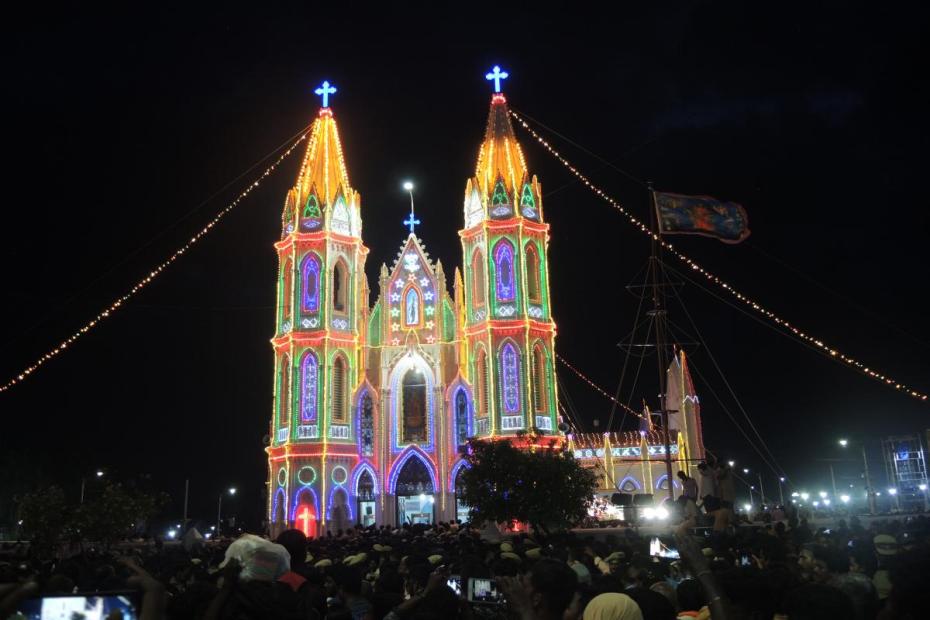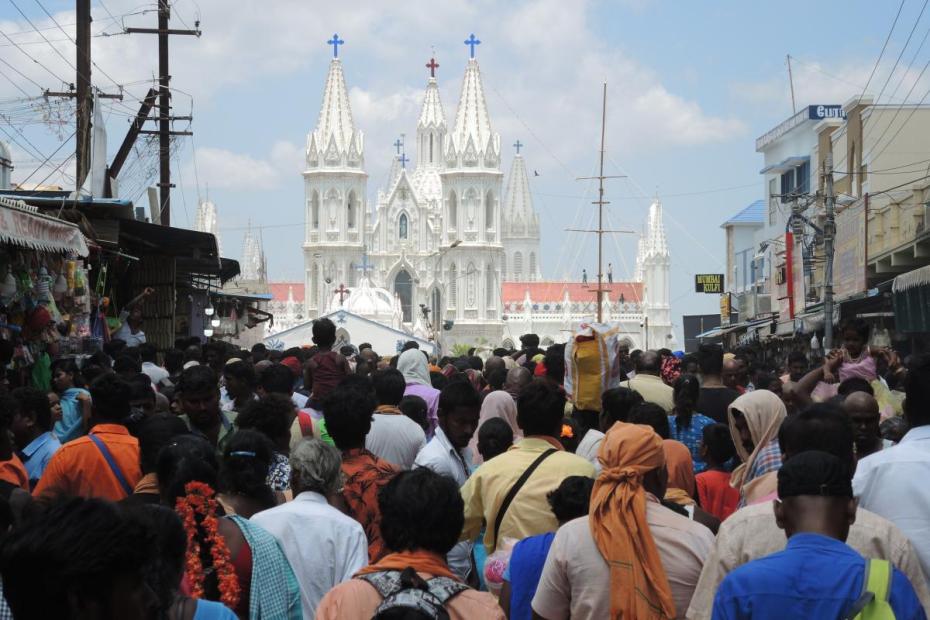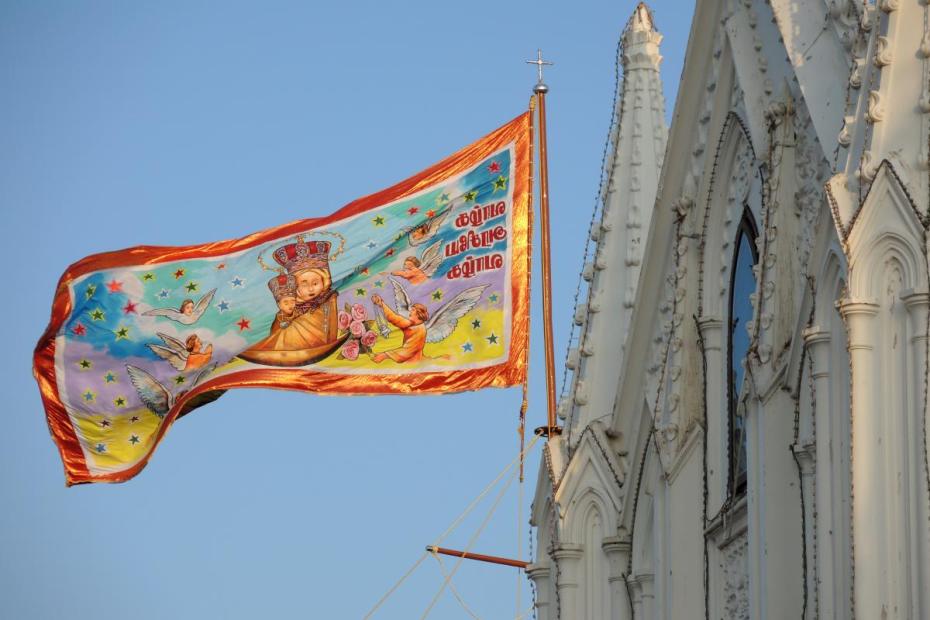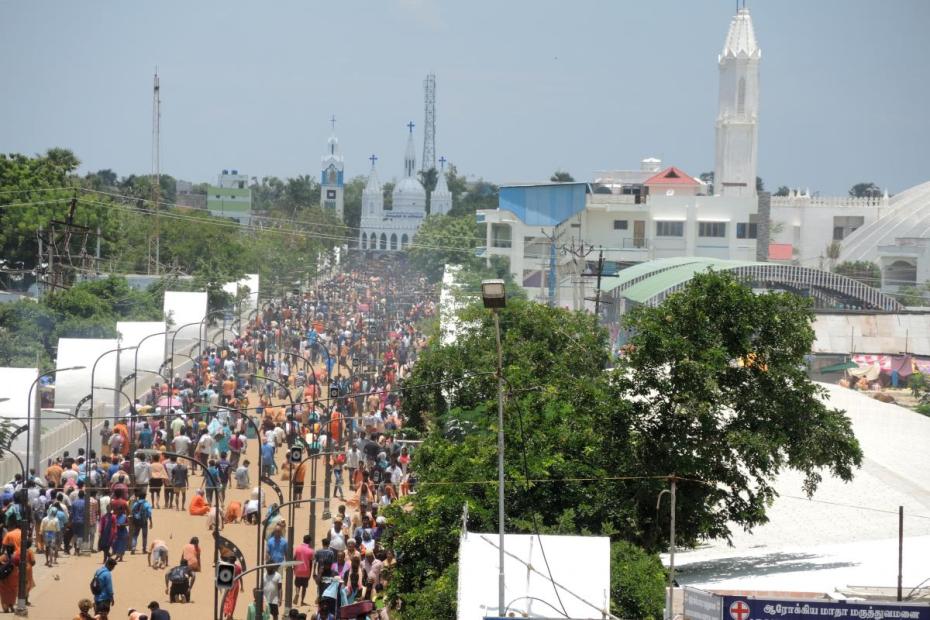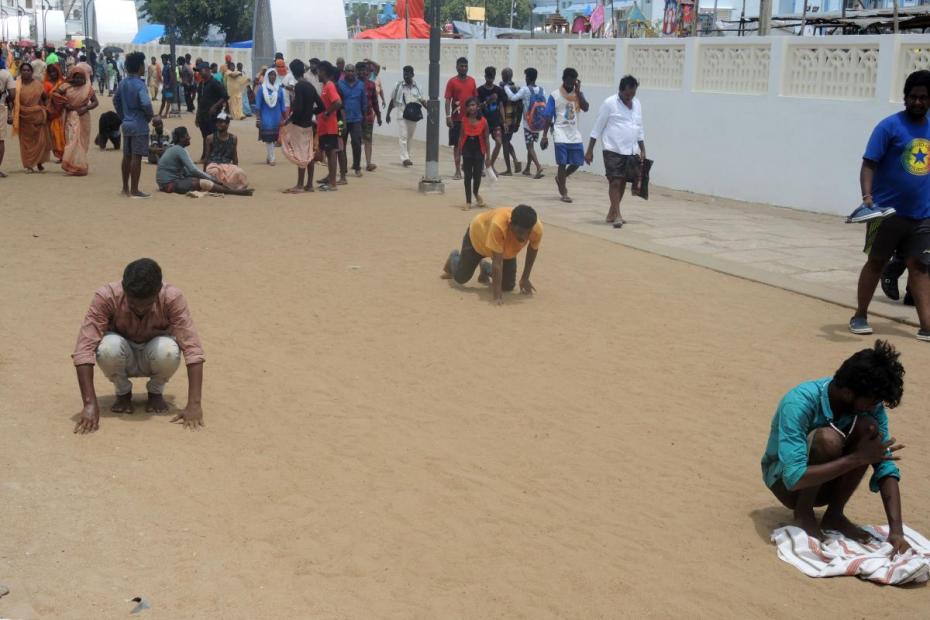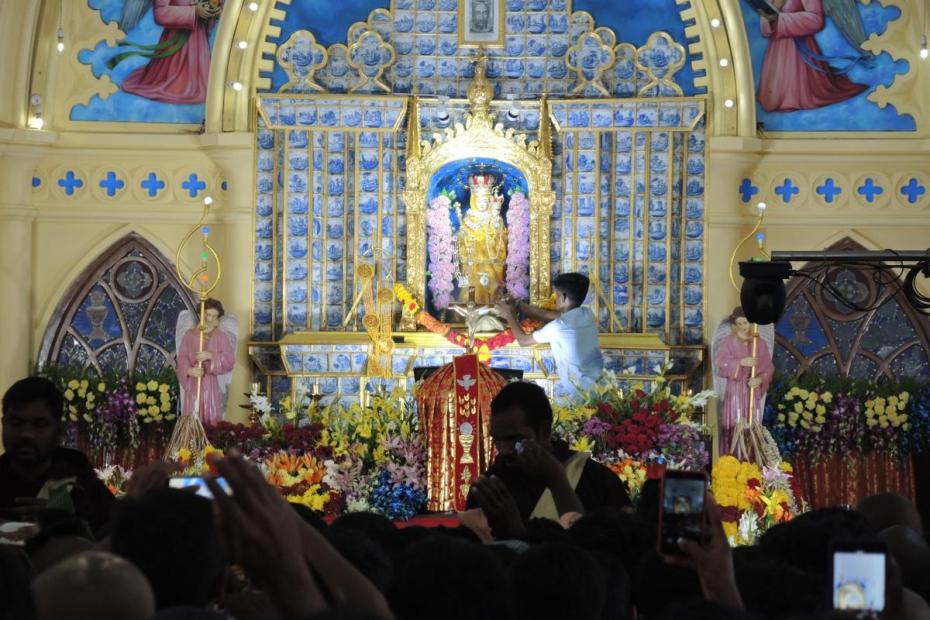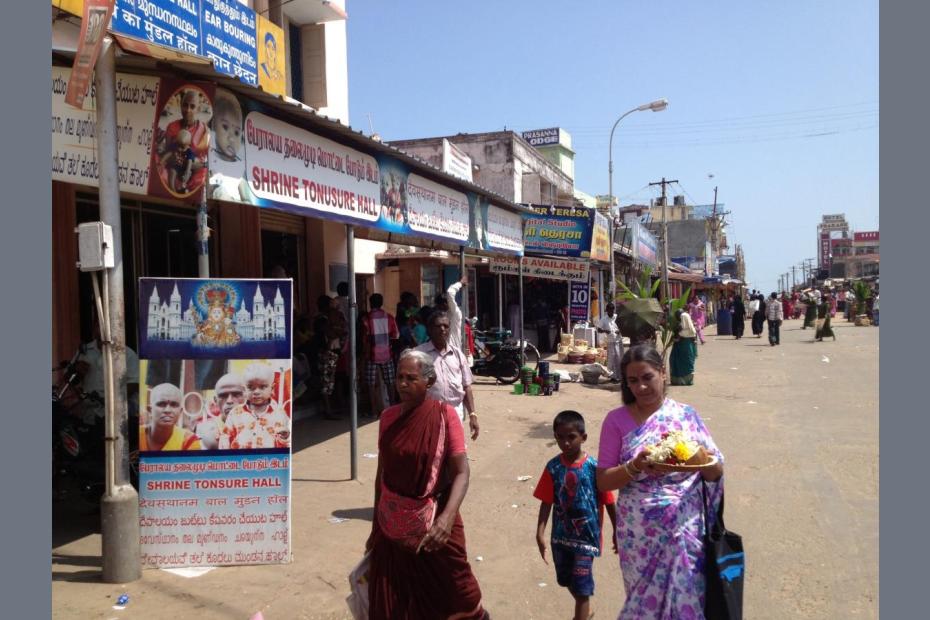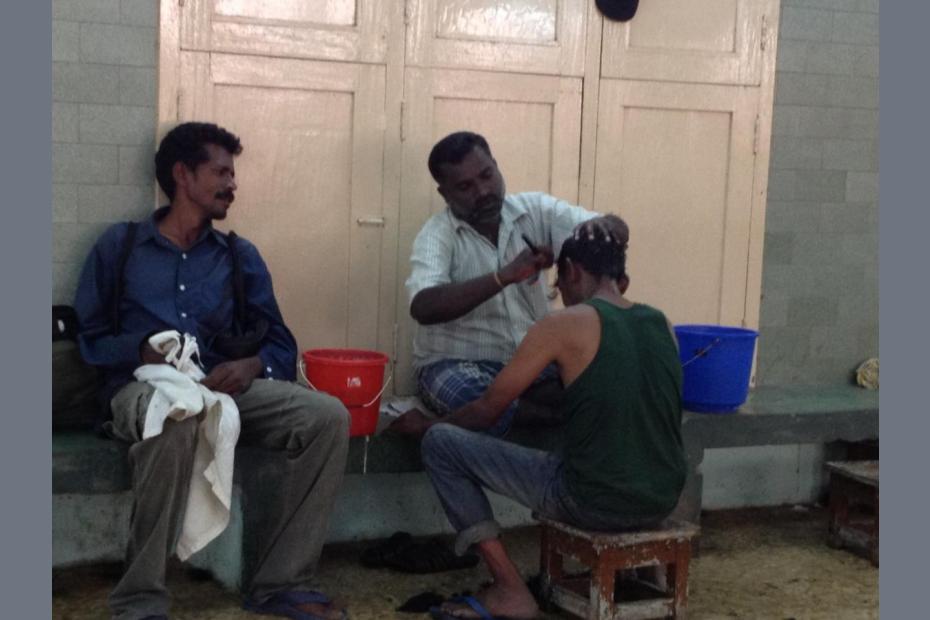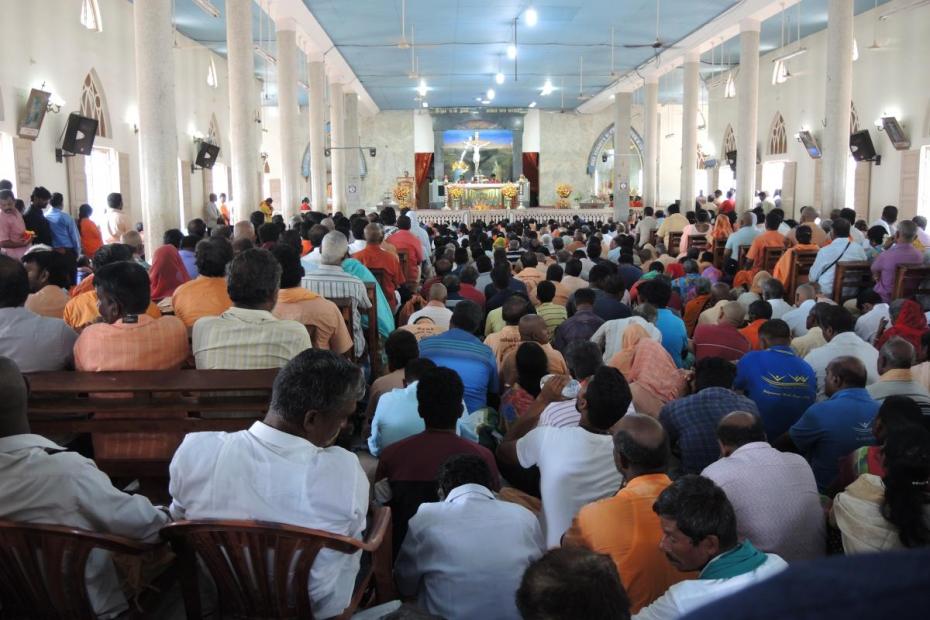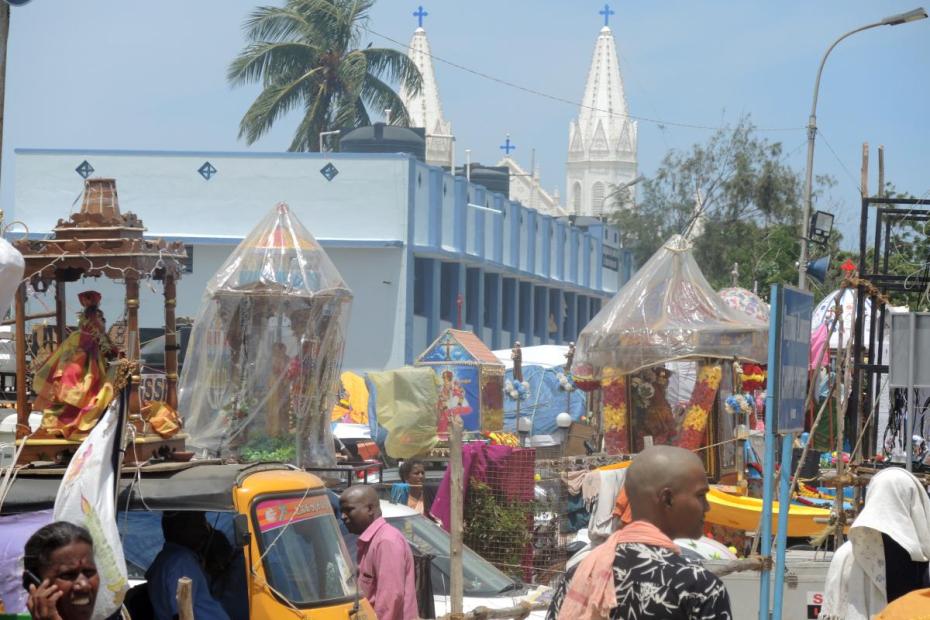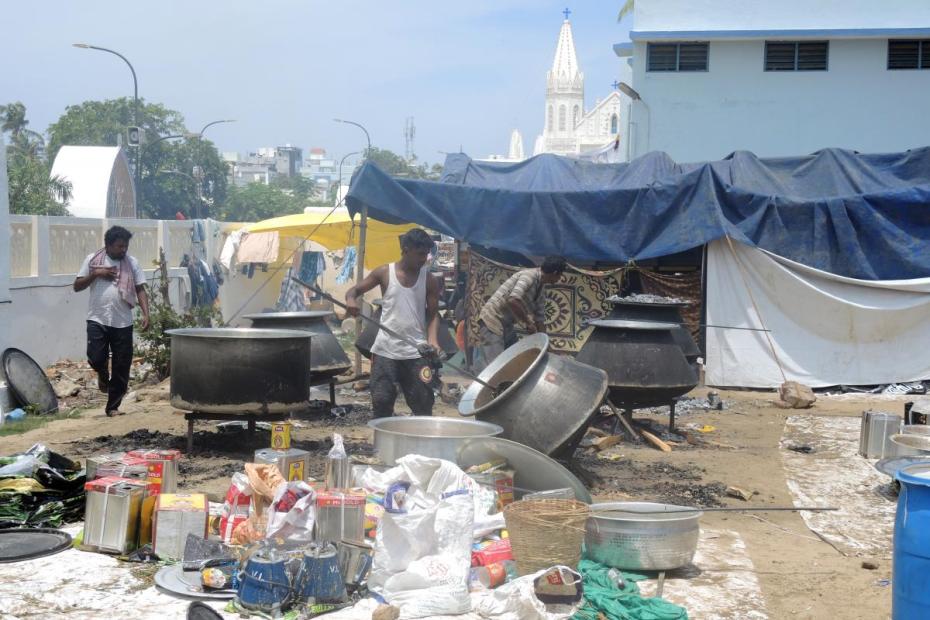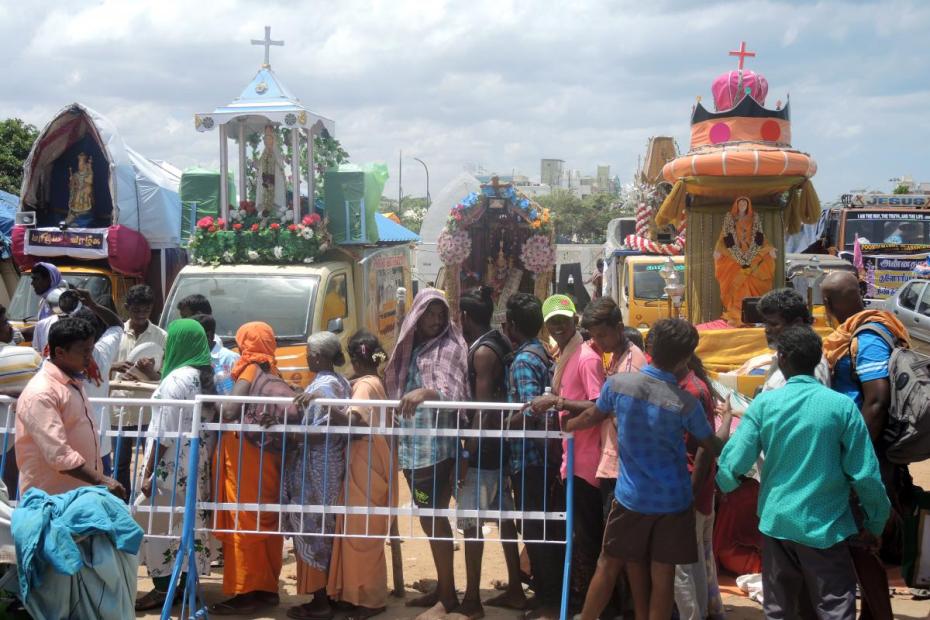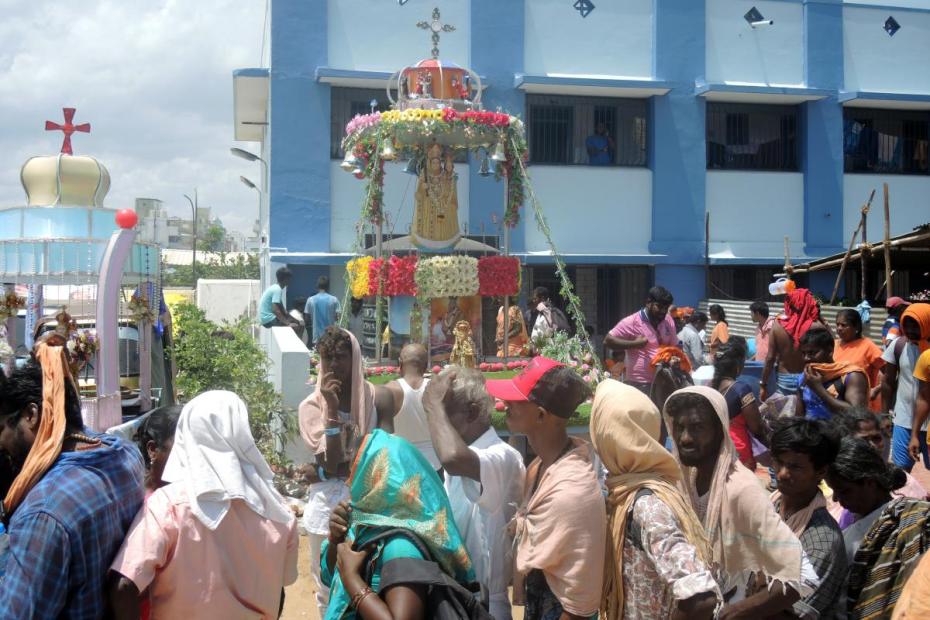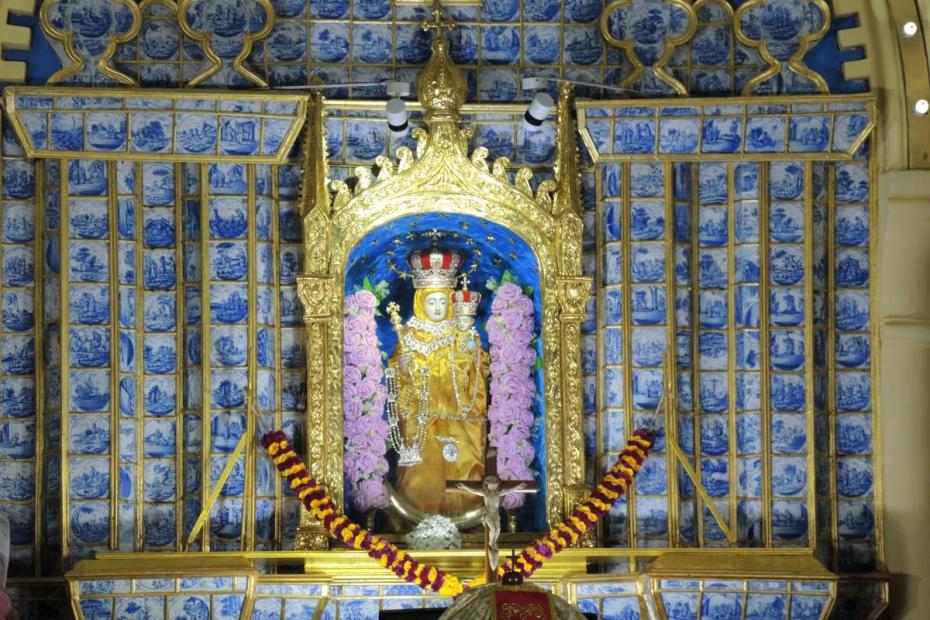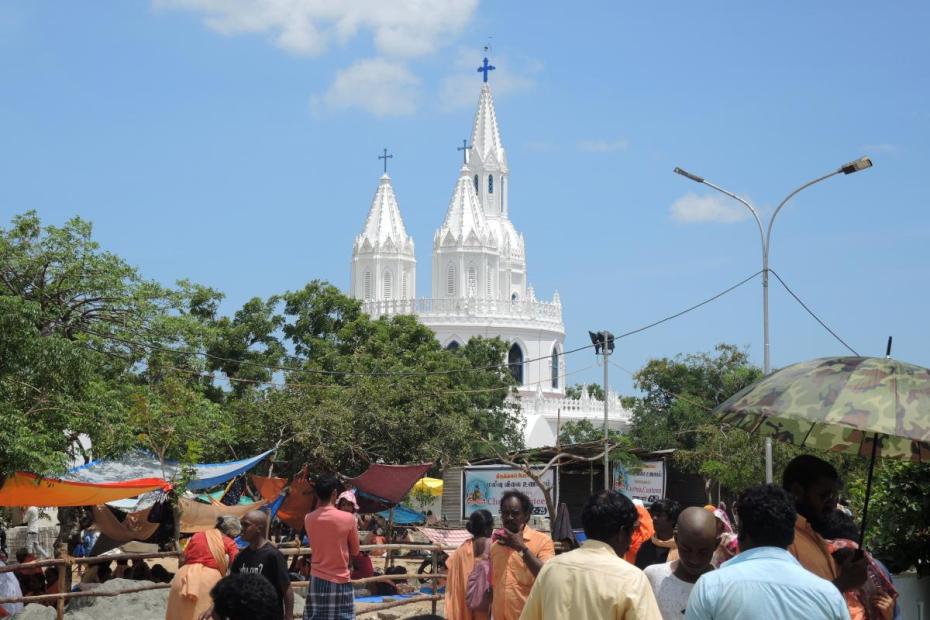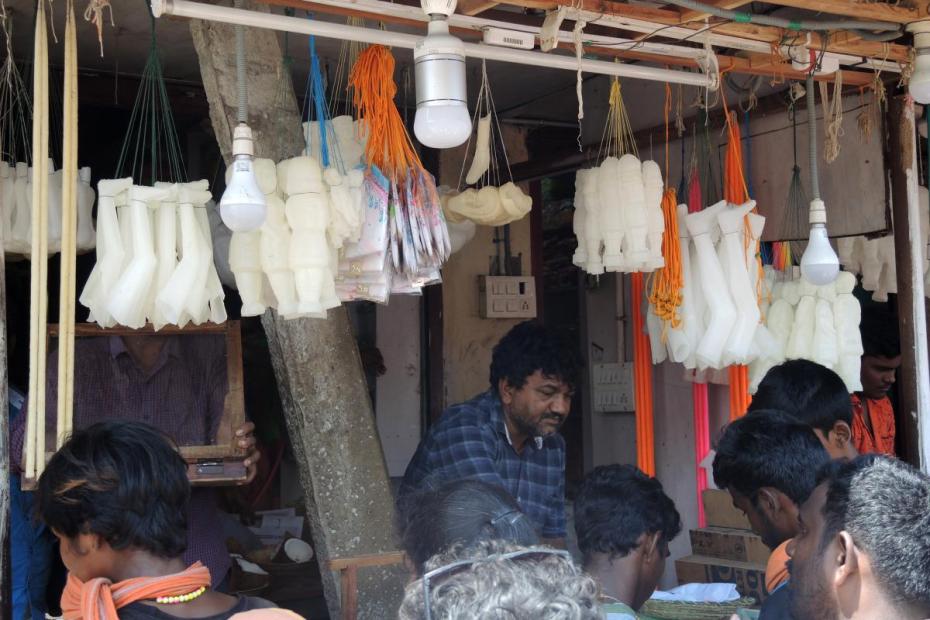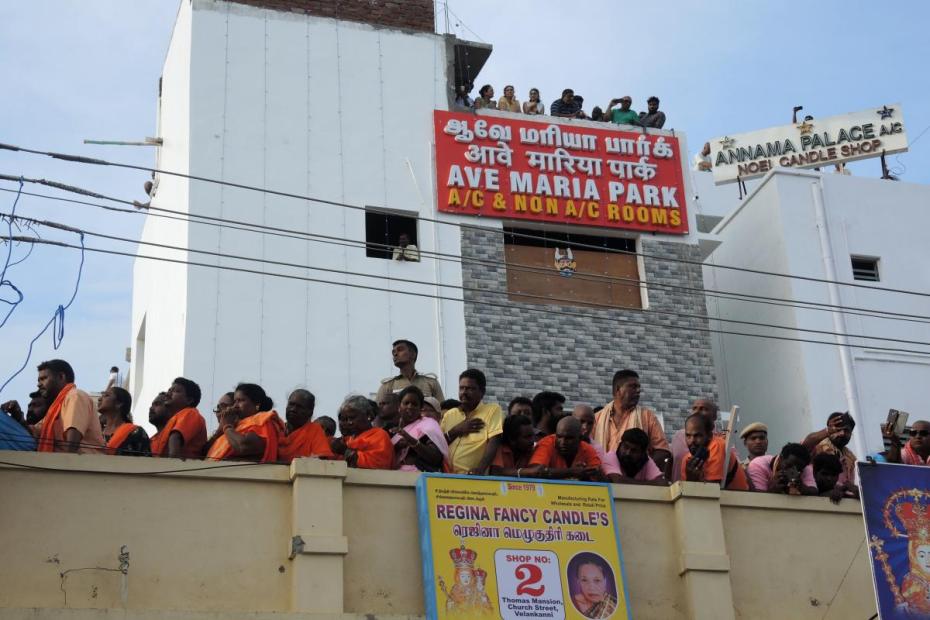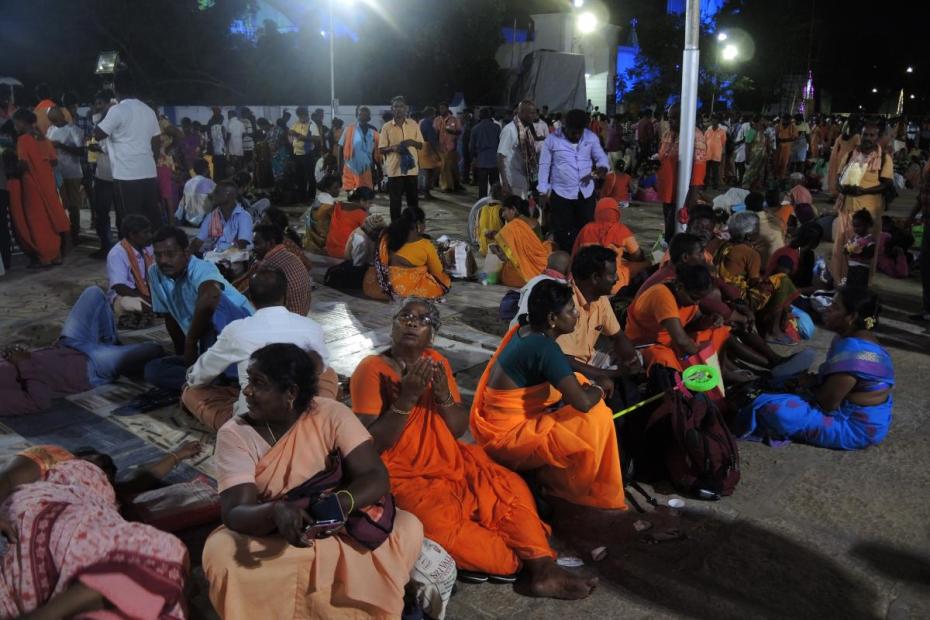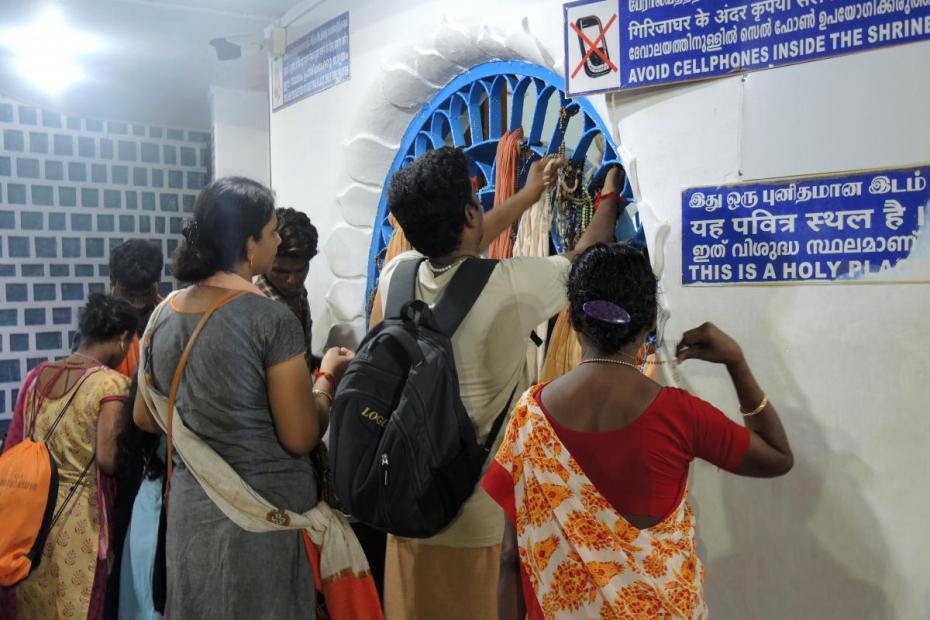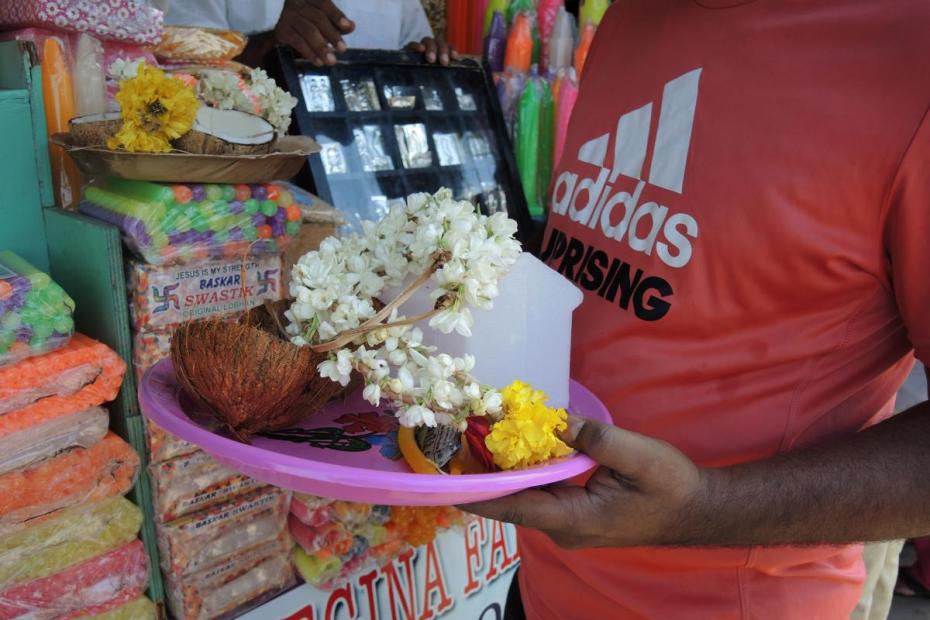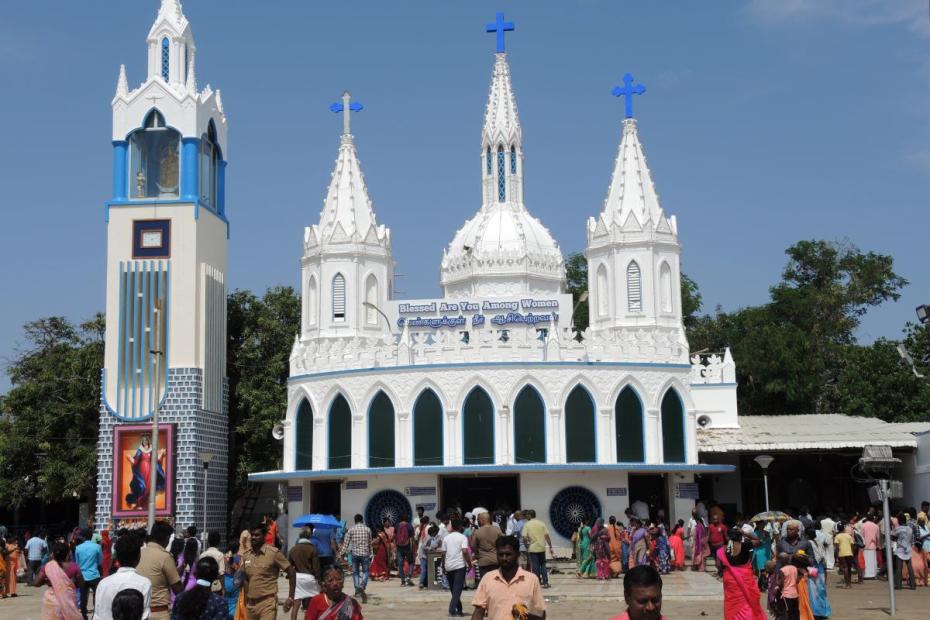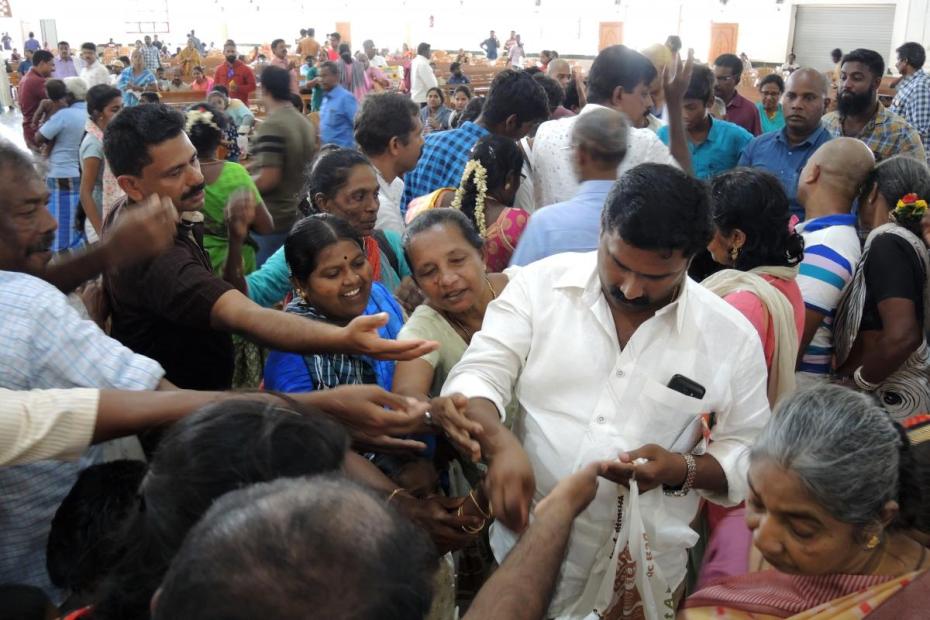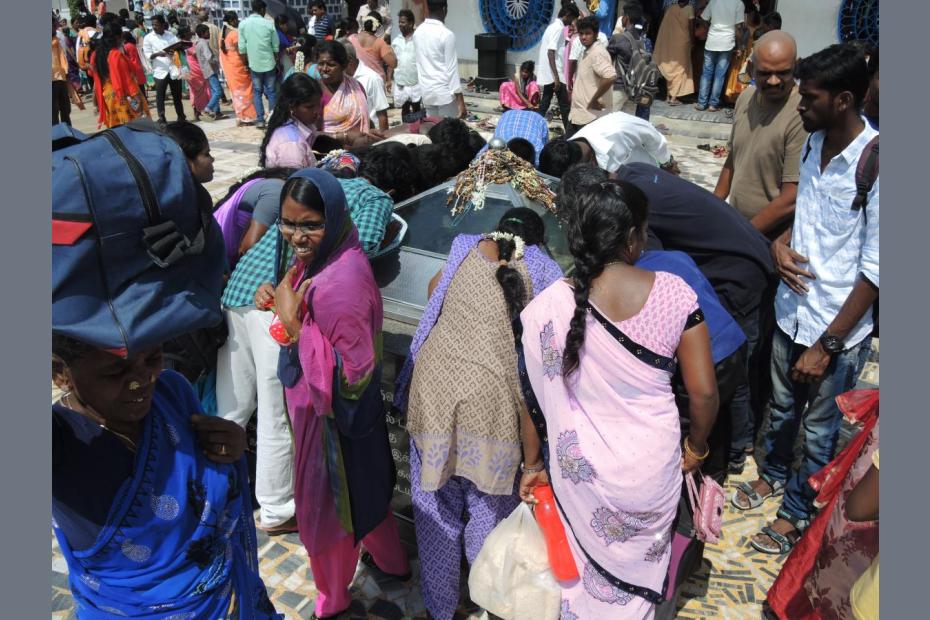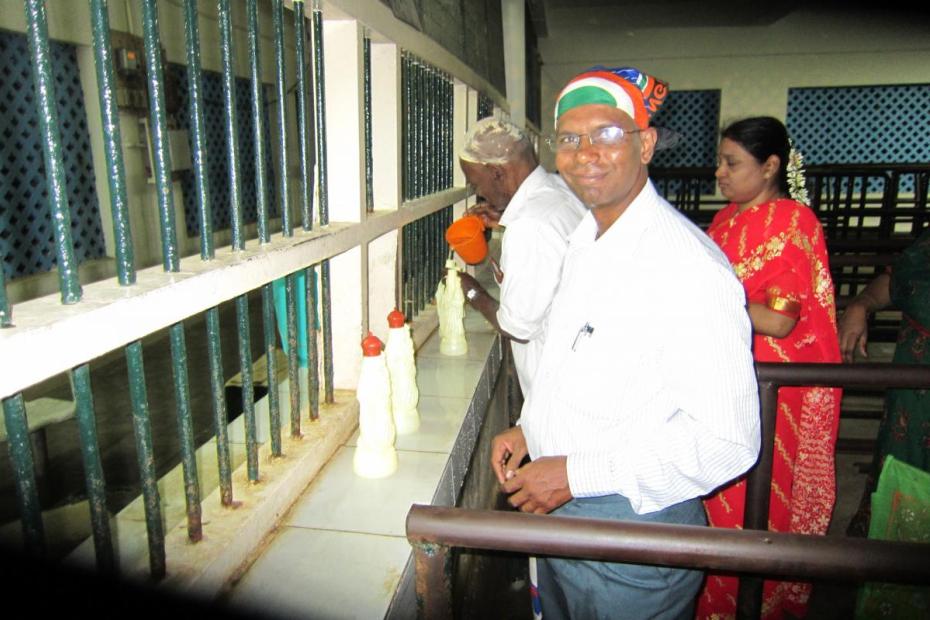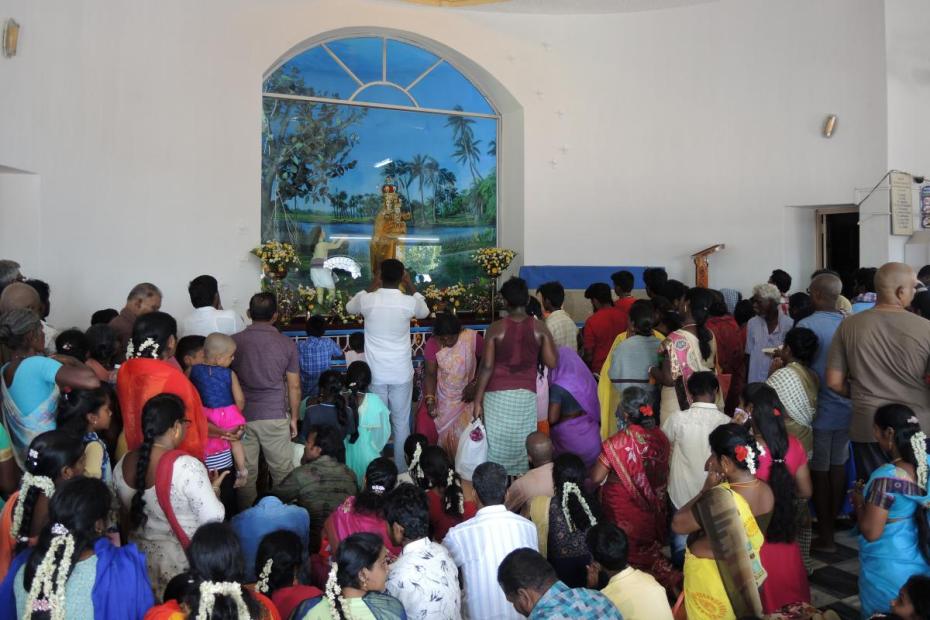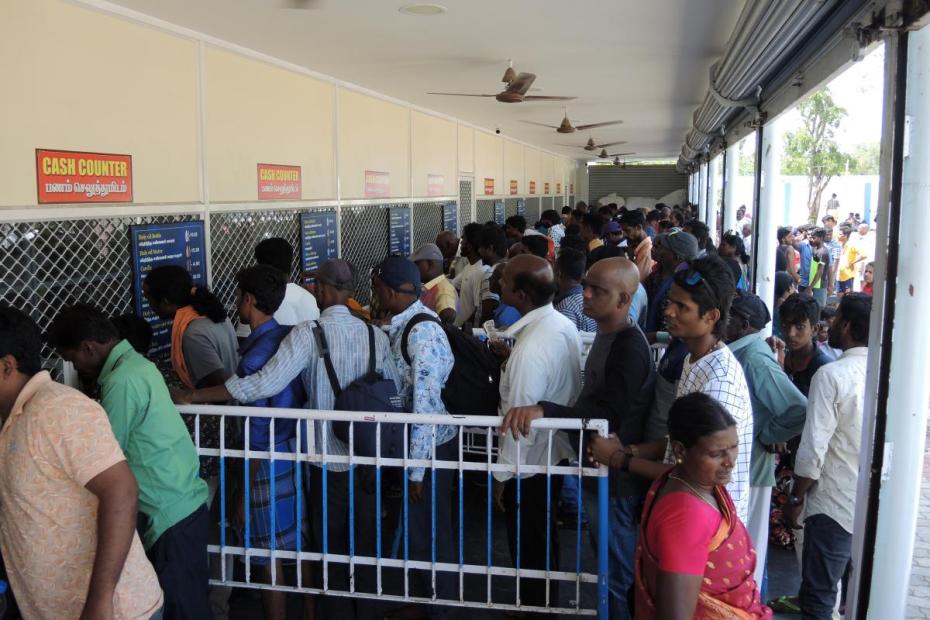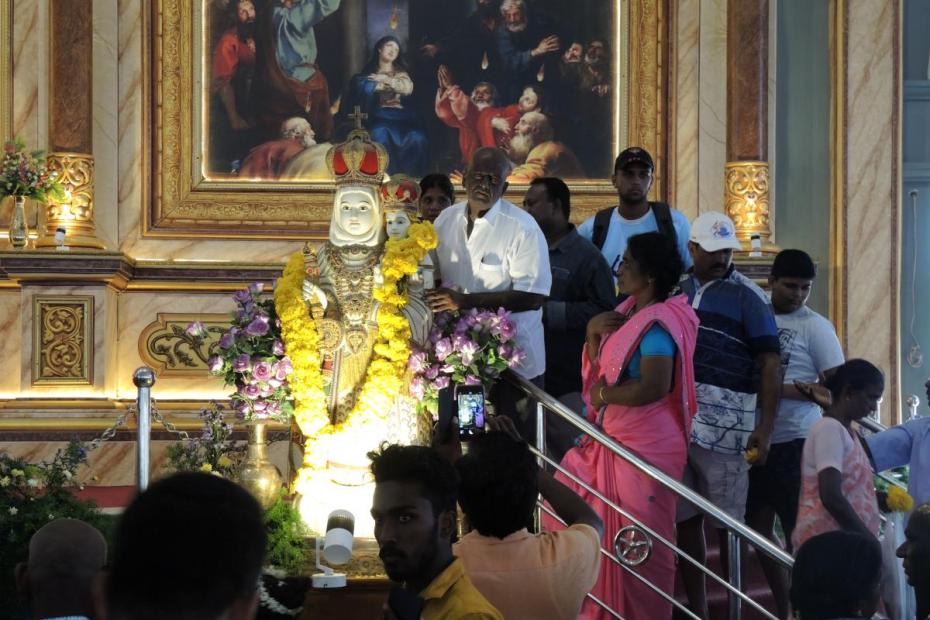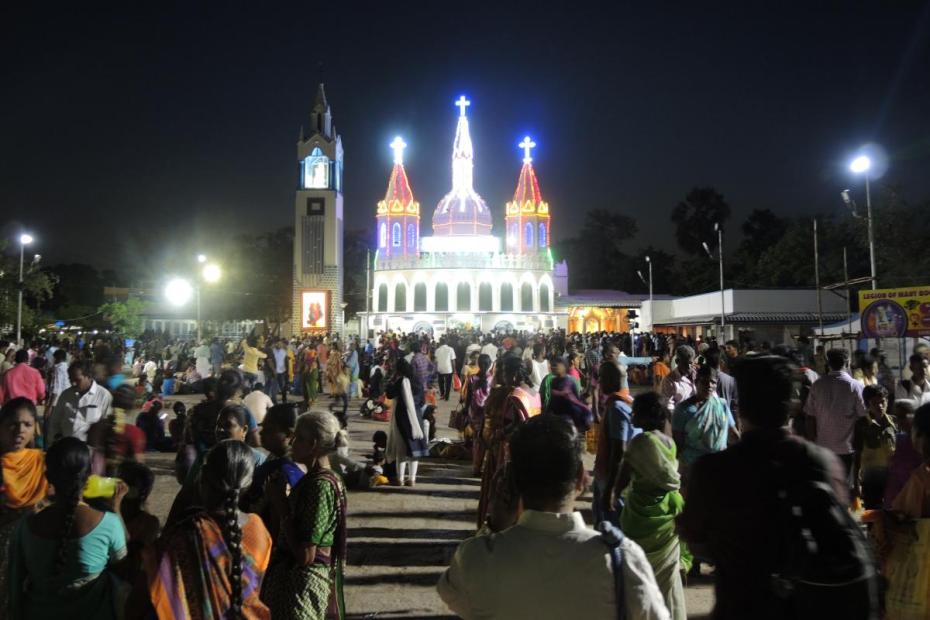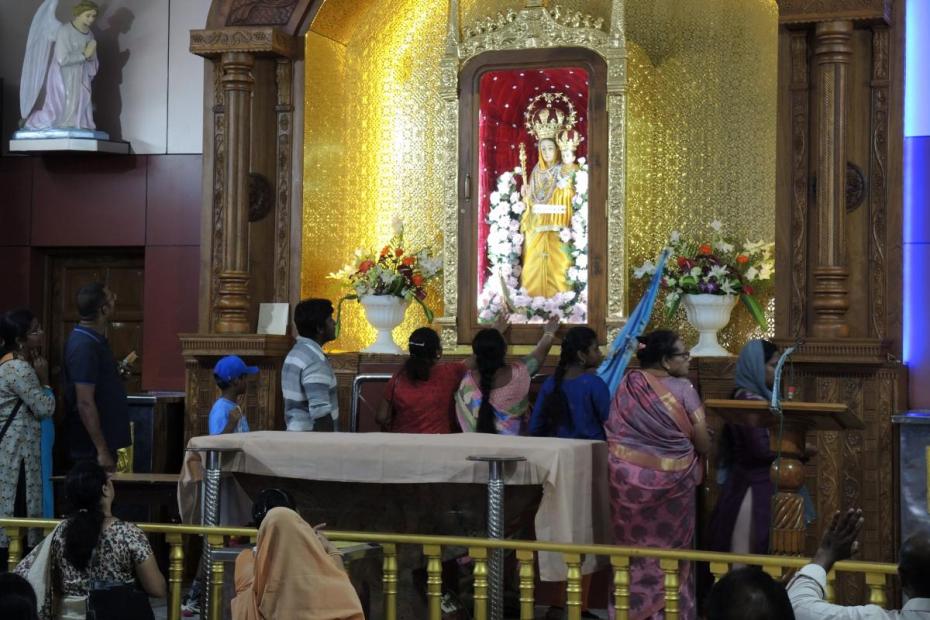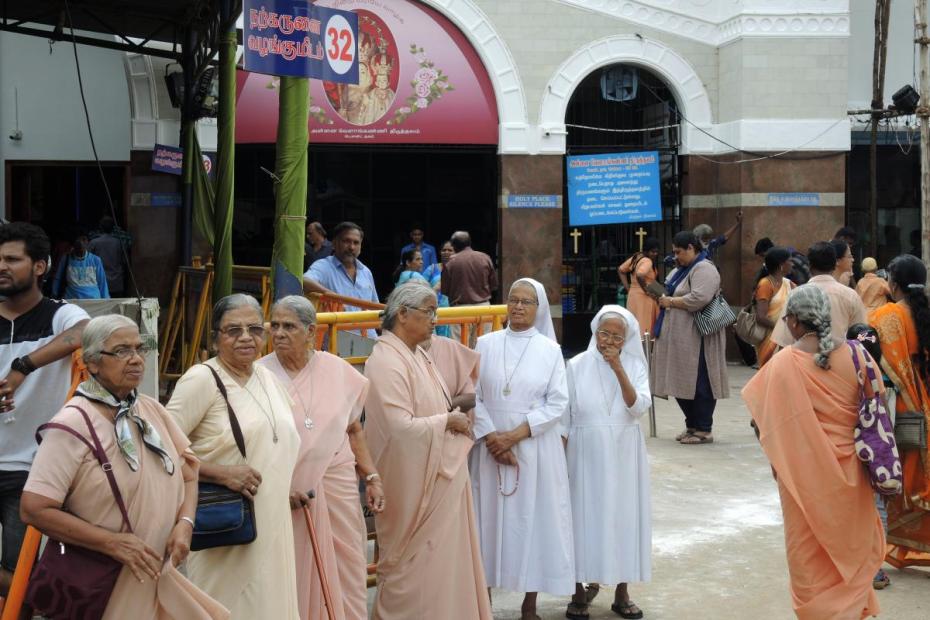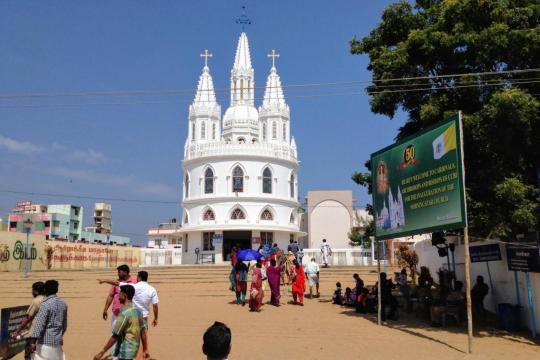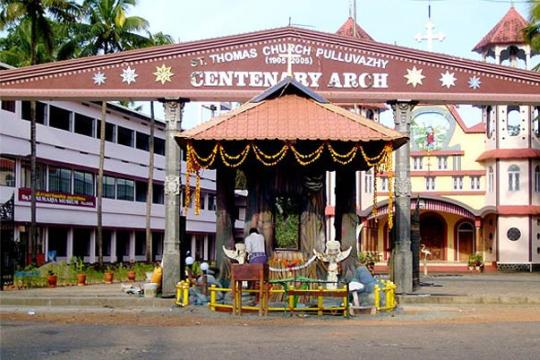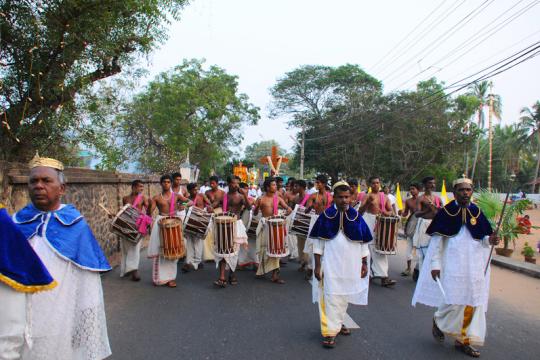Shrines and feasts play a central and highly visible role in Indian Catholic practice. In addition to the many local shrines and the annual feasts that are hallmarks of parish life, there are several important pilgrimage sites that draw pilgrims from a distance. The most important of these is a large shrine complex dedicated to Annai Velankanni (sometimes spelled Vailankanni), Our Lady of Velankanni, located a few hundred meters from the Bay of Bengal in the state of Tamil Nadu (or Tamilnadu). The shrine, referred to by many Indians as the "Lourdes of the East," occupies much of a village where Mary is said to have appeared twice in the 16th century.1 Velankanni attracts millions of visitors a year, especially during the annual 11-day feast, culminating on September 8, and in May and at Christmas. A number of parishes in Tamil Nadu are also named in her honor, and a 30-year-old shrine to her at Besant Nagar in Chennai draws hundreds of thousands of people for her feast and its novena. Catholic devotion to Annai Velankanni is powerful, and her image can be seen on stickers affixed to vehicles throughout southern India. Remarkably, about 70% of the participants at the feast are Hindus and Muslims.
The title Annai Velankanni, Our Lady of Velankanni, is in keeping with the global norm for Marian titles, but she is more likely in ordinary discourse to be called, Velankanni Mata, or Amma, both of which mean Mother. Interviewees at the shrine were clear that they adored her not as a royal lady, but as a mother.2 This is not to say that she is not powerful—quite the contrary—but that her power derives from her status both as devotees’ mother and Jesus’ mother. The English traditional title that resonates most closely is “Blessed Mother.”
The shrine’s staff is cautious about ascribing numbers, but broadly estimates that 400,000 to 500,000 pilgrims were present in Velankanni on the opening and closing days of the feast in 2019, perhaps 200,000 a day on the feast days in-between, and that as many as 5 million visitors come over the course of a year.3 The size of the crowds and the scale of the shrine complex, and its roots in appearances of Mary to young people, certainly warrant comparison to Lourdes, but the style and form of devotion here is unique to its South Indian context.
Days of Devotion
September 8, the date when the worldwide Church marks the birth of Mary, is the official date of the Feast of Annai Velankanni. But the feast begins 11 days earlier, on August 29, when the shrine is packed in anticipation of the flag hoisting at dusk. It continues over a nine-day novena, culminating on the feast day. The format, which dates back to a cooptation of local practice by 16th-century Jesuit missionaries, “replicates Hindu Navarāttiri festivals at goddess temples with nine-night, ten-day celebrations and a climactic event on the final day.”4
For many pilgrims, though, the preparation begins even before that. Interviewees often indicated that they had fasted for 40 days before the flag hoisting to prepare themselves. That entailed one or two missed meals a day, or abstinence, often done in Hindu fashion, by limiting oneself to a vegetarian diet.
Some Velankanni pilgrims walk there from great distances, most often traveling 300 km over the course of 10 days from Chennai, sometimes after having traveled by other forms of transportation to that city. As they recounted it, pilgrims simply walk along the side of the road, wearing saffron clothes to identify themselves. Some prefer to walk when it is cooler at night, but others said that they walked on during the day and met up in groups at predetermined spots to sleep at night—sometimes at parish grounds, or often simply on the side of the road. Some walked barefoot, a custom they recognized as linked to Hindu tradition, as is the tradition of wearing saffron. Catholic pilgrims said that their pastors discouraged the walking journey, saying that it was excessive and could be dangerous.
August 29, flag-hoisting day, is one of the two most crowded days of the year. Pilgrims see the hoisted flag not simply as a sign that the feast is in session. The flag itself, seemingly as much as the statue of Annai Velankanni, is sacred to pilgrims, and the ceremony to hoist it is a sacred moment. As the flag, which has her image on it, is hoisted, the crowd raises its hands, prays and chants “Mariae vazgha,” Praise to you Mary, towards it. The tradition of raising a flag as a form of devotion appears to be unique to India, and is part of parish feasts as well.5 The day of the flag hoisting, people tightly pack the streets around the basilica, and the flag and a large decorated statue of Annai Velankanni are paraded through the streets before the flag is blessed and hoisted. The crowd is rapturous, and many in it sing the Velankanni Madha flag song. The flag is raised again every day at noon with song and fireworks, but the opening evening is special.
The vast majority of pilgrims travel there as families. Sometimes groups of young men travel there together, and in a few instances families indicated that one or two of their number had walked there, while the rest of the family drove later to meet them. Women could not safely come as a group without their families, though one group of young women in school uniforms was visible, accompanied by religious sisters.
The temperature at that time of year climbs each day to a very humid 35°c (95°F), but some people still walk barefoot around the shrine on what is surely very hot pavement. Many others find a spot in the shade for their families, which could be the same space they sleep in at night. Though it is busy during the day, the heat ensures that the site is even more active after sunset, when it is a bit cooler. Pilgrims said that they passed the day visiting a variety of images of Amma, often leaving an offering or offerings there; praying as a family, usually by saying the Rosary; attending a daily Mass; and conversing with other pilgrims. A steady stream of pilgrims traveled the 600-meter sand path from the basilica to the “tank” church on their knees.6 At least 100 people were lined up at any time to commission Mass intentions or to receive Holy Water from the tank church. Masses, even in the heat of the day, were generally full.
Some parts of the shrine have a slight religious theme park quality, with small parks, statuary fountains, and didactic exhibits on salvation history, but these were typically the least crowded parts of the site.
To a non-Indian, one of the most striking elements of devotion at the feast is the form of offering and devotion in front of Annai Velankanni. Many pilgrims, including Catholics, make their offering in traditional Hindu form: on a bamboo (now sometimes plastic) plate; a half coconut; fluorescent-colored candles; orange, red and yellow garlands; and occasionally some visible symbol of what they are praying for, or thanking her for giving them—a wax house, or a pressed tin symbol of what it is that people need to be healed. A small number carry a several-foot-tall coconut tree sprout. Catholic devotees borrow from the cultural repertoire of south Indian Hindu practice, but certainly not from its whole range of practice.
As often happens in India, the devotees and the items offered typically spend very little time in front of Annai Velankanni. They are often quickly moved on to make room for a continuing flow of offerings, and even resold. A few women donate saris to adorn Annai Velankanni. Afterwards, the saris are resold at a booth nearby. 7
Devotees are aware of the resonances with Hinduism, and neither try to distance themselves from the link, nor do it as an ideological statement. Walking, barefoot, making these offerings, wearing saffron is “just what we do,” interviewees repeatedly stressed. One Catholic man was a bit more thoughtful about it, saying that he regarded the split coconut as a sign of a pure heart broken open before Annai Velankanni.
Though the pace of things never slows down much during the nine-day novena, it shifts back to high gear on September 7, the eve of the feast. Late in the afternoon there is an outdoor Mass, usually celebrated by the local bishop. Following Mass, an evening procession past the front of the church and through the streets is a highlight of the day. As Mass wound to a close, police cleared a path through the streets and women staff swept the same path clean in the traditional fashion. Dozens of Legion of Mary members, priests, nuns, and a throng of green-shirted male youth volunteers kept the path clear as a procession made its way featuring images of Archangel Michael, St. Sebastian, St. Anthony, St. Joseph, the Immaculate Conception, and Our Lady of Mount Carmel, all carried by groups of women.8 Finally, this was followed by the grandest image of all, Annai Velankanni, brightly lit in the darkness, carried by young men. The excitement around her was palpable. The choice of images largely reflected popular south Indian devotions, saints to whom particular miraculous power is attributed. Notably absent were St. Thomas the Apostle, the unofficial patron of India, who is said to have brought the faith there and been buried in Tamil Nadu; St. Francis Xavier, whose missionary efforts transformed the church in Tamil Nadu and was known to have stayed nearby; and St. John de Britto, another missionary saint killed and buried nearby, and more contemporary Indian saints.9
The young men and women who carried each statue had waited in line much of the day for the privilege, and carried the images on their shoulders, walking barefoot. The men who carried Annai Velankanni spoke afterward almost giddily about how excited they were that she could bring Catholic and Hindu men from different villages, faiths, and—more remarkably to them—castes. “This feeling is an awesome feeling… We carry as a unity…There is no caste feeling here... It is like a blessing of your mother, [for] your shoulder to be touched. It’s like your wish, your dreams, there are so many things that people have in their heart... you get once in a lifetime blessing from her because your shoulder is touched by her chariot,” various members of the group chimed in. The next morning at 4:45 a.m. they would carry it again, and were brimming with excitement at that possibility. “It’s her birthday, so we’ll be carrying her for her birthday.”10
September 8, the closing day, was packed all around. There was another outdoor Mass, plus many more in the various churches. In the huge new Morningstar church, which seats 10,000, a Malayalam-language Mass was nearly full, and a subsequent Tamil Mass about one-third full. As in pre-Vatican II churches, one could often see women praying the Rosary or kneeling before a statue of Mary as Mass proceeded. Throughout the day, visitors proceeded in the same sorts of devotions as during the novena.
At dusk, the feast officially came to a close with a flag lowering, but even then the grounds did not empty out. People crowded the streets to see it, and in the compound where it was taken down the invited guests crowded to touch the flag, while the men in charge raced to fold it and return it to the sacristy. The music was sadder, but the shrine did not empty out. As cool came, it was crowded again, like any other night of the feast, though most people would leave that night or the next morning. Important as the walk there is for some pilgrims, most return home by bus or train.
The attraction of Annai Velankanni
Velankanni commemorates three reputed 16th-century miracles. The first was the appearance of a dazzling woman holding a child in the village to a poor Hindu boy who had been sent on a task to deliver milk, but offered some to her when she asked for it. Subsequently, the milk in his pot was overflowing. The second was very close by, to a poor, lame Hindu boy, a buttermilk seller, who was also asked to give the child milk. He gained the ability to walk. Each boy is said to have brought a witness who confirmed the apparition. The latter was a Catholic man who is said to have erected the first small chapel on the site. The third miracle was that she appeared to desperate Portuguese sailors in a violent storm, and saved their lives. They promised to build a church where they came ashore, and built a more permanent structure to Our Lady of Good Health (a name still attributed to Annai Velankanni today) on the site of the village chapel. “Tamils, meanwhile, called her Ārōkkiya Mātā (ārōkkiya means “health”) or Veḷaṅkanni Mātā (veḷai means “white”; kaṇṇi means “maiden”)—and the place came to be known as Velankanni.” 11
The shrine’s staff, including more than a dozen full-time priests, works to focus attention not only on Annai Velankanni, but on Jesus. At the Tamil Mass, for example, the homilist was quick to remind people that though they may ask favors through Amma, it is Jesus who accomplishes the work. Whether people ultimately believed that was difficult to discern. A giant Sacred Heart statue is under construction, and the sand path was lined with life-size stations of the Cross, but these were clearly not the focus of attention for pilgrims. A staff of a dozen priests, supplemented by twice as many more during the feast, offers Masses and hears confessions in seven Indian languages. These do seem to be an important part of pilgrims’ practice.12 Some 35-50 people at a time were praying in the Eucharistic Adoration Chapel.
With lay staff, the priests also offer counseling at the shrine. Most of that, counselors report, involves matters of family discord. Priests and deacons are located in several locations, including the basilica, to bless objects and people. Interviewees typically spoke only in broad generalities about the difficulties that brought them there, but counselor-priests said that they typically involved “family problems.” Among the people interviewed were couples who had been trying to conceive a child, and who had come here to pray that they finally could. One young man had traveled the 600-meter sand path on his knees with that request, and he and his wife were confident that they would be blessed. Another man, a Hindu, said that this was the 14th year he had walked the 300 km from Chennai, and that he did so because he had prayed for his father to stop drinking. Amma had miraculously granted it, and he returned every year to give thanks, though he remained a Hindu. Others indicated that alcohol was behind many families’ problems. In Indian fashion, these were “family” problems, not “personal” ones.
It was quite difficult to get interviewees to describe any particular qualities that they saw in Annai Velankanni, to describe what she is like. Descriptions were consistently as simple as these, despite requests for more: “I just feel blessed when she looks down on me, smiling.” “She is caring.” “She is a woman, so she understands me.” “She is a mother, so she understands. I can talk to her.” “I feel happy around her.” Interestingly, no one described her ability to relate to them as being tied to aspects of the Virgin Mary’s life, to her experience of suffering, as is sometimes the case in Spanish and Portuguese contexts. She simply understood because she was a mother, their mother. A. Maria Arul Raja, S.J., suggests that devotion to her for a role, not for particular, special characteristics, speaks to her status as an Indian archetype: a woman blessed with a male child.13 So important is this in traditional culture, that all other qualities of her life pale. Annai Velankanni is regarded not only as a mother, but also as a mother with a powerful male son, is especially compelling a society where a male son is highly prized. Others pointed out that in Indian society, fathers can be distant and even stern, and that a mother is the person one goes to to make an appeal for help.
Though people did not often talk readily about their particular suffering, it was obvious from simply watching pilgrims that Velankanni has the capacity to draw together people who are visibly suffering and at a loss, and people whose joy was palpable. Suffering and joy are visible side-by-side.
By all accounts, around 70% of the attendees at the shrine are not Catholics. The shrine is well aware of it, and priests routinely announce that Communion is for Catholics properly prepared to receive it, and that it is not simply prasadam, the Hindu sanctified foods left at shrines for people to take home as a blessing. Many or most people in the crowds are Hindu, and some are Muslim. Such a flood of devotion to Mary by non-Christians may seem especially puzzling to readers in parts of the world where devotion to Mary is seen as a quintessentially Catholic phenomenon (especially ones with large Protestant populations). Perhaps even more puzzling may be that those devotees have such a strong devotion to her, but see no need to become Catholic. But in India it is not puzzling to interviewees at all.
To many Hindus at the feast, Annai Velankanni is a manifestation of Mariamman, "Mother Mari," a Hindu mother goddess popular in Tamil Nadu, known for protecting health and for bringing rain, and therefore, abundance.14 The yellow and red that some feast attendees wear are colors associated with her, whereas for Catholics, blue might be the color of choice. Muslims can be at home in terms of devotion insofar as Mary is mentioned in the Quran more than in the New Testament. Catholics reported that they were very happy to have Hindus and Muslims there. People avoided religious controversy at the shrine, they said, but at a time when there was political pressure from hardline Hindu nationalists in India, this proved what typical people really believed, and the rest was drummed up by politicians, several said.15 Often, they said, non-Catholic visitors asked Catholics to pray to Annai Velankanni for their needs, and they were happy to do so.
What seems to make Annai Velankanni stand out most of all for visitors is the possibility, even likelihood, that some miraculous change will result. The shrine itself stresses the miraculous qualities of the place, and has a small museum attesting to these. Interviewees spoke without hesitation about many miracles in others’ and their own lives. Unlike at the healing waters at France’s Lourdes, no one described this as a site where miracle cures happen instantly, on site. But people referred to miracles in their lives that happened over the course of the year after, a sort of slow unfolding of grace whose source, they were certain, was due to their prayers to Annai Velankanni.
Clearly, traveling to her and being with her is an important element of devotion, something that can bring greater blessing. Being able to touch an image is extremely important to devotees in south India, though here, like elsewhere in India, physical distance, or glass, is used at the shrine to prevent too much touching. The interviewees who carried the image stressed not the hardship that they endured to carry her, but the blessing that came because their shoulders had actually touched the platform that carried her. When the flag came down, many of the hundred or so people allowed in the enclosed area raced to touch it. Whatever hardships are entailed being there, touch, more than sacrifice, seems to be a key mechanism for encountering the holy and communicating spiritual power.16
A devotion that has expanded and continues to expand
Until 25 years ago, Velankanni was a much smaller village, though today its population is still about 12,000. The current shrine’s basilica, in Gothic style, was consecrated in 1933, and was granted the status of basilica in 1962. In 1971 a museum was built to house ex votos of miracles claimed by visitors. A large, two-level extension was built on the back of the basilica in 1974, to accommodate simultaneous pilgrim liturgies in India’s major languages. A 1971 Tamil-language film, Annai Velankanni, played a major role in popularizing the devotion beyond the local area.17 The rest of the shrine complex—the tank church and other chapels, the sand path from the basilica to the tank church, the many dormitories, etc.—has been built up since then. In 2004, an Indian Ocean Tsunami wreaked havoc all around the shrine, taking hundreds of lives the day after Christmas, a peak time for attendance. Construction continues to the present day, including a massive Morningstar church, whose seating capacity of 10,000 makes it the largest church in India, and huge new dormitories.
Many parishes in Tamil Nadu are also named after the Mother of Velankanni, including one that hosts the city of Chennai’s largest shrine to her. In 2019 some 200,000 people showed up at that shrine for the flag hoisting alone, according to local newspapers. The parish is now building a church that will be one of the largest in the city.
- 1Though the apparitions have not been officially approved, the shrine with her images is recognized by the Holy See as a minor basilica. A third miracle took place at sea, and Velankanni is where the sailors landed afterwards.
- 2This article is based on two visits, during the off-season in February 2014, and during the feast in 2019. Over that time, in English or with help from a Tamil translator or an English-speaking family member, I interviewed 12 different families and two groups of young people about their pilgrimage and devotion.
- 3Local newspapers and police were no more helpful with estimates. The grounds and nearby streets were certainly crowded throughout the feast, enough to make the feast estimates credible. It was difficult to say how many people were there in total, given that some people stayed as little as a day and others spent the whole time there. The city provides a special, much larger bus depot during the feast with dozens of buses coming and going, and special trains as well. During a weekday visit to the shrine in February 2014, there were 2-3,000 visitors there. Particular thanks are due to Frs. M.K. George, S.J., and Lawrence Fernandes, S.J., for their guidance in opening doors to the shrine on each visit, and to Simon Anand Raj for his help as a guide and translator.
- 4Kristin C. Bloomer, Possessed by the Virgin: Hinduism, Roman Catholicism, and Marian Possession in South India (Oxford University Press, 2018), 14, 109.
- 5Building elaborate flag masts is now commonplace in Tamil Nadu parishes, a tradition that they say came from Kerala. John Guy, New York’s Metropolitan Museum of Art curator for South and Southeast Asian art, reports that temple flags announcing the deity inside have been part of Indian temple culture since at least the second or third century AD.
- 6The “tank” church is a round church that commemorates the site of the 16th-century Marian apparition at an artificial pond—in local parlance, a “tank.”
- 7In contrast to the talk that I heard about miracles at Velankanni, David Mosse asserts that the saris “are treated as protection against harmful forces rather than (as in the Christian West) relics for veneration in the quest for miracles. David Mosse, The Saint in the Banyan Tree: Christianity and Caste Society in India (University of California, 2012), 305.
- 8This is notable given that Bloomer (118) reports, “In all of Tamil Nadu, in all of the processions that I witnessed, whether Hindu or Catholic, only men pulled the cart… Women might process ahead of the cart, but men always carried, pulled or walked beside it.” How recent a change this is at Velankanni is unclear.
- 9The choice of saints was also likely a legacy of some years of competition between Jesuits and Franciscans in town. The Franciscans eventually won out, and were interested in spreading devotions like St. Anthony. Notably, too, except as a child in the arms of Annai Velankanni, Jesus was missing.
- 10In other parts of Tamil Nadu, caste has played a role in battles over who gets to carry or accompany floats in processions, so this would be a refreshing change for devotees. For a Hindu example, see Bloomer, 134-6.
- 11Bloomer, 14.
- 12This is apparently true for many Hindus as well. Priests routinely announce that Communion is for Catholics properly prepared to receive it, and that it is not simply prasadam, the Hindu sanctified foods left at shrines for people to take home as a blessing.
- 13Personal conversation. Thanks to Frs. A. Maria Arul Raja, S.J., and Michael Almadoss, S.J., of Loyola College Chennai, for their help thinking through what I encountered at Velankanni.
- 14To what degree people see her as Mariamman is difficult to determine from conversations. Mariamman is a fierce goddess, very different from Mary as she is known in the Christian tradition. On these differences, and their manifestations among the devotees she studies in Tamil Nadu, see Bloomer, 28, 44. Since Hindu perspectives are not a primary concern of this research, the matter was not pursued. David Mosse (81) notes that unlike many Christian saints whose story and religious devotion is rooted in violence, such as the form of their death, Mary’s “power is unimplicated in violence.” This would make her quite different from Mariamman. Mosse asserts (84-85) that at Velankanni, Alapuram Catholic pilgrims leave aside the dualistic elements of the goddesses, and encounter her a benevolent force, but also acknowledges (298) that others may see a more ambivalent goddess.
- 15Two events in 2019 gave people reason to be more concerned than they indicated they were. During the walking pilgrimage preceding the feast, a group of pilgrims carrying an image of Annai Velankanni was attacked by members of a radical Hindu defense organization that opposes Christian conversions and objected to having a Christian statue taken through their town. The feast also took place under the shadow of alleged security threats against the shrine by Islamist terrorists said to have recently infiltrated the region. Police were evident all over town, but the atmosphere was not tense at all.
- 16One curious opposite between Indian and much Western Catholicism: touching statues is not important in much of the West, but touching through shaking hands at the kiss of peace often is (and more than some clergy would like). In India, touching the holy image is something that is limited by clergy, but at the kiss of peace, people offer a simple bow with hands folded to a few people, yet never touch.
- 17The film is available online, in 10 segments, on YouTube, beginning at https://youtu.be/V97OA2nDf-g.
